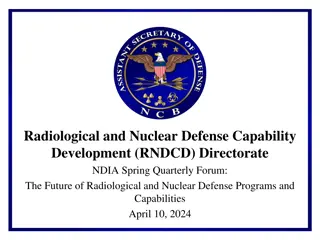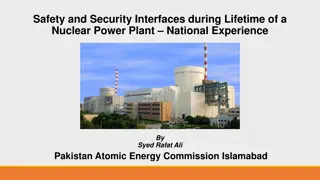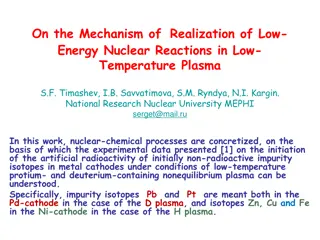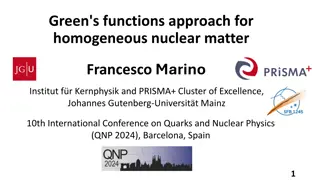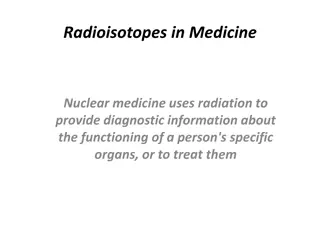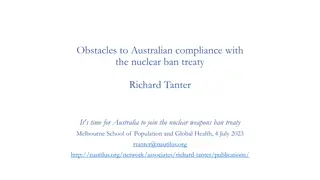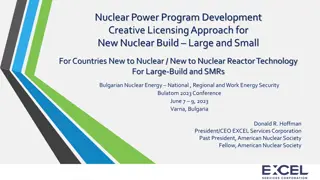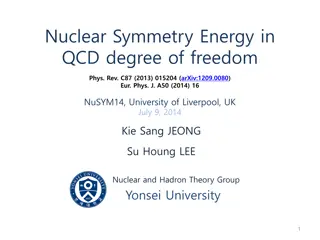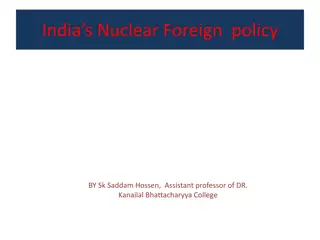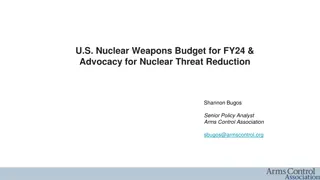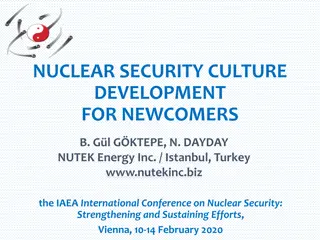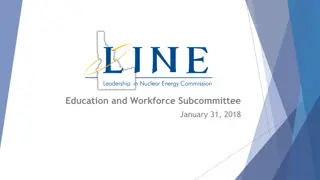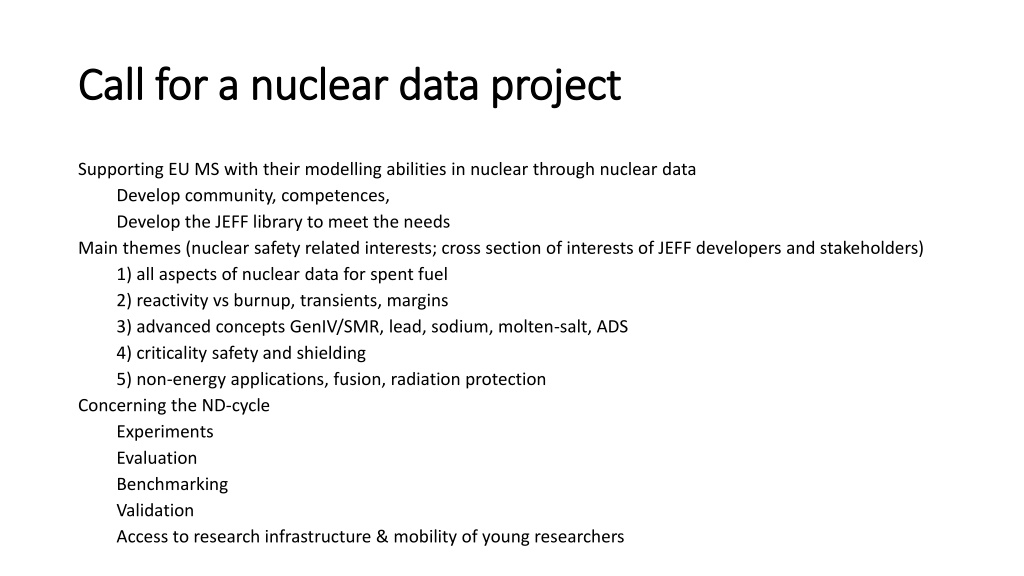
Enhancing Nuclear Data Capabilities for EU Modelling
Support the EU Member States in improving their nuclear modeling skills through comprehensive nuclear data projects focusing on various aspects such as spent fuel data, reactivity vs. burnup, advanced nuclear concepts, criticality safety, and non-energy applications. Develop the JEFF library to address the evolving needs of the nuclear industry stakeholders and developers.
Download Presentation

Please find below an Image/Link to download the presentation.
The content on the website is provided AS IS for your information and personal use only. It may not be sold, licensed, or shared on other websites without obtaining consent from the author. If you encounter any issues during the download, it is possible that the publisher has removed the file from their server.
You are allowed to download the files provided on this website for personal or commercial use, subject to the condition that they are used lawfully. All files are the property of their respective owners.
The content on the website is provided AS IS for your information and personal use only. It may not be sold, licensed, or shared on other websites without obtaining consent from the author.
E N D
Presentation Transcript
Call for a nuclear data project Call for a nuclear data project Supporting EU MS with their modelling abilities in nuclear through nuclear data Develop community, competences, Develop the JEFF library to meet the needs Main themes (nuclear safety related interests; cross section of interests of JEFF developers and stakeholders) 1) all aspects of nuclear data for spent fuel 2) reactivity vs burnup, transients, margins 3) advanced concepts GenIV/SMR, lead, sodium, molten-salt, ADS 4) criticality safety and shielding 5) non-energy applications, fusion, radiation protection Concerning the ND-cycle Experiments Evaluation Benchmarking Validation Access to research infrastructure & mobility of young researchers
All aspects of nuclear data for spent fuel All aspects of nuclear data for spent fuel Main application targets Spent fuel management Reprocessing (continuous or otherwise) Data needs (microscopic) for inventory, source of radiation, heat and dose rate estimation Fission yields U-235, Pu-239 thermal(-epithermal) Key nuclides (Nd-148, Cs-137, Sr-90, ) Full set (IFY, CFY, ratios to burnup indicators) Fission, capture and total cross sections of major actinides (U-235, U-238, Pu-239, Pu-241) Fission, capture and total cross sections of minor actinides (Pu-242, Am-243, Am-241, ) For above: distinguish between needs for experiments and evaluations Fission product capture and total cross sections (burnup credit/spent fuel management) Data needs (integral) for inventory, source term, heat and dose rate estimation Decay heat benchmarks (Fission pulse, fusion pulse - FNS, CLAB, is there more?) Inventory benchmarks (SFCOMPO, ) Source of radiation and dose rate benchmarks (are there any?) Burnup credit benchmarks (are there any?) For above: investigate if and which benchmarks exist (IRPhE, ), select the most important, analyse status of the libraries
Reactivity vs burnup, transients, margins Reactivity vs burnup, transients, margins Main application targets LWR, boron let-down curves, trends and uncertainty margins Transient analysis (Delayed neutrons, FP poisoning) Credibility of a nuclear data library (important applications should be able to use the library: GenIII+, SMR) Data needs (microscopic) for inventory, source term, heat and dose rate estimation Major actinide thermal and epithermal fission, capture and total cross sections, nu-bar, neutron spectrum (eta, alpha) Delayed neutrons (summing calculations versus group data). For above: distinguish between needs for experiments and evaluations Data needs (integral) for inventory, source term, heat and dose rate estimation Boron let-down curves Inventory benchmarks Delayed neutron, beta-eff, lambda-eff benchmarks For above: investigate which benchmarks exist, select the most important, analyse status of the libraries
Advanced concepts GenIV/SMR, lead, sodium, molten-salt, ADS High priority request list: bulk of the requests are from SG-26 GenIV advanced concepts (SFR, LFR, GCFR, VHTR with EPR as a reference). Current interest are SMRs. There is a large overlap for the data needs with GenIV studies so HPRL remains relevant to a large degree. However, in ANDES and SANDA it was demonstrated that the type of concept considered may change the priorities. So, stay close to needs for designs that are important now, meaning: receiving study by well-funded projects, now and in the future. Use, the more recent sensitivity studies to set the priorities: SG-46 and related work (ESFR-SMART, MYRRHA, ) Priorities are for experiments, evaluation, validation For systems under design and without operational experience we can only make impact studies. Important for the designer, but useless for understanding how well data perform. We need to identify the set of benchmarks that are most representative and cover the data interests of the designs being considered. See again, SG-46 and related work. For MSRs more work is needed to establish the data needs. Strongly depends on the concept.
Advanced concepts GenIV/SMR, lead, sodium, molten-salt, ADS SG-46 Target Accuracy Requirements (TAR) Executive summary, severely abbreviated (Read it!) INL/Terrapower, MACRE: 35Cl(n,p) 2-10 MeV, 2%; 235U(n,g) 2-500 keV 1.2-1.4%. UPM/Moltex:Moltex SSR-W 35Cl(n,p) 0.5-2 MeV, 1%; 239Pu(n,g), 2-67 keV, 1.3%; ENEA/Alfred: 239Pu(n,f) 2-67 keV 0.6-0.8%; 239Pu(n,g) 2 keV-2 MeV 2-4%; 238U(n,g) , 1-2%; 238U(n,inl) 67-500 keV 6-7%, 0.5-2MeV 3%; 207Pb(n,inl) 5%. UPM: Alfred, Astrid, ESFR, JSFR and Nuscale: Table 66 of report Modifies SG-26 recommendations of the HPRL for 238U(n,inl), 239Pu(n,f), 240Pu(n,f), 206Pb(n,inl), 207Pb(n,inl), 56Fe(n,inl), 23Na(n,inl); Adds to HPRL: 239Pu(n,inl), 56Fe(n,el), 23Na(n,el), 235U(nu-bar), 235U(n,g); P1 needs 16O(n,el) & 238U(n,el) SCK-CEN, MYRRHA: 240Pu(n,f) 2 keV-2 MeV 2-5%; 240Pu(n,g) 2-500 keV 4-6%; 239Pu(n,f) 20 eV-67 keV 2%; 239Pu(n,g) 1.5-3%; 238U(n,f) 2-20 MeV 1.6%; 238U(n,g) 67 keV-2 MeV 1.5-2.5%
Criticality safety and shielding New evaluated libraries for fission and fusion measure performance by benchmarking. Most prominent are criticality benchmarks and shielding benchmarks. These are of immediate concern in criticality safety, fusion and radiation protection (people and/or equipment). A new version of a library must outperform previous versions of the library. In JEFF, still regards the NEA-Mosteller suite but aims to broaden the range of benchmarks reflecting applications, quantities and specific nuclides of interest. This broader suite needs further developing (and include shielding, beta-eff, see other themes; JEFF-3.3 paper and recent JEFF meetings). List of benchmarks, (open) set of inputs, pipelines to run the simulations and comparisons Specific needs from recent JEFF meetings, JEFF-3.3 paper are for the following materials JEFF-3.3: PE, D2O, Be & BeO, C, F, Al, concrete, S, Steel, Cu, Er, Hf, W, Pb, Th, Np Recent ICSBEP feedback: B, O, 16O(n,el) ad 0.1-300 keV, Ca, Si, Ni, 58Ni(n,el), Cu, 63Cu, 186W(n,el), 233U nubar, pfns 0.1- 5 MeV and 0.01-0.1 eV , 235U(n,g) URR, 239Pu(n,f) and nu-bar 0.01-0.5 eV Recent shielding feedback: Zr, Mo, Al, Cu (Oktavian; elastic, inelastic, angular distributions-ad, 6-14 MeV)
Non-energy applications, fusion, radiation protection
Community and competence building Excellent community for measurements of basic data; dedicated work requires resources, as usual Physics level evaluations: we are short of people for resonance region evaluation, focussed fast range evaluations (reactions). There is new momentum in FY evaluations, but much less in DD evaluations. We need to train young people working with REFIT, CONRAD (SAMMY), DD evaluations: PhDs and Postdocs, ideally with an experimental side to the work so they understand what they are evaluating. We need to create awareness with managers that the link with applications is nearly broken. Positions are needed. Investments in experimental facilities and personnel do not serve the applications without the extra step of evaluations. Developing scientific insights do not make it to users of data, the modelling community.
Community and competence building Files and libraries need quality assurance: benchmarking and validation Support the JEFF initiatives at professionalizing the benchmarking by determining new selections of benchmarks, automating the simulations and comparisons and developing strategies for better making sense of the outputs (effective feedback)
Develop the JEFF library to meet the needs Define specific JEFF related objectives and deliverables Targeted evaluations: Which files will be delivered? Who picks up results of measurement campaigns of previous EC ND projects? Targeted benchmarking: which aspect will be tackled and how (above)? Targeted new experiments: tackle priority needs (above) how will the new experiments fit the nuclear data pipeline, i.e., who will evaluate once results are there? Define the JEFF release we are targeting JEFF-4.0 scheduled for December 2024: If it outperforms JEFF-3.3! JEFF-4.1, not scheduled yet, could be fall 2028 (so just after project closure).


